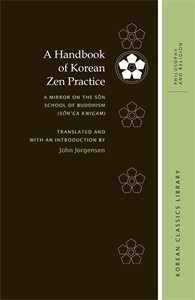A Handbook of Korean Zen Practice: A Mirror on the Sŏn School of Buddhism (Sŏn’ga kwigam)
- About the Book
-
Sŏn (Japanese Zen) has been the dominant form of Buddhism in Korea from medieval times to the present. A Handbook of Korean Zen Practice: A Mirror on the Sŏn School of Buddhism (Sŏn'ga kwigam) was the most popular guide for Sŏn practice and life ever published in Korea and helped restore Buddhism to popularity after its lowest point in Korean history. It was compiled before 1569 by Sŏsan Hyujŏng (1520–1604), later famed as the leader of a monk army that helped defend Korea against a massive Japanese invasion in 1592. In addition to succinct quotations from sutras, the text also contained quotations from selected Chinese and Korean works together with Hyujŏng's explanations. Because of its brevity and organization, the work proved popular and was reprinted many times in Korea and Japan before 1909.
A Handbook of Korean Zen Practice commences with the ineffability of the enlightened state, and after a tour through doctrine and practice it returns to its starting point. The doctrinal rationale for practice that leads to enlightenment is based on the Mahayana Awakening of Faith, but the practice Hyujŏng enjoins readers to undertake is very different: a method of meditation derived from the kongan (Japanese koan) called hwadu (Chinese huatou), or “point of the story,” the story being the kongan. This method was developed by Dahui Zonggao (1089–1163) and was imported into Korea by Chinul (1158–1210). The most famous hwadu is the mu (no) answer by Zhaozhou to the question, “Does a dog have a buddha-nature?” Hyujŏng warns of pitfalls in this practice, such as the delusion that one is already enlightened. A proper understanding of doctrine is required before practicing hwadu. Practice also requires faith and an experienced teacher. Hyujŏng outlines the specifics of practice, such as rules of conduct and chanting and mindfulness of the Buddha, and stresses the requirements for living the life of a monk. At the end of the text he returns to the hwadu, the need for a teacher, and hence the importance of lineage. He sketches out the distinctive methods of practice of the chief Sŏn (Chinese Chan) lineages. His final warning is not to be attached to the text.
The version of the text translated here is the earliest and the longest extant. It was “translated” into Korean from Chinese by one of Hyujŏng's students to aid Korean readers. The present volume contains a brief history of hwadu practice and theory, a life of Hyujŏng, and a summary of the text, plus a detailed, annotated translation. It should be of interest to practitioners of meditation and students of East Asian Buddhism and Korean history.
- About the Author(s)
-
John Jorgensen, Translator
John Jorgensen is senior research fellow at the China Studies Research Centre, La Trobe University.John Jorgensen, Author
John Jorgensen is senior research fellow at the China Studies Research Centre, La Trobe University.Sosan Taesa, Author
Robert E. Buswell, Jr., Series Editor
Robert E. Buswell, Jr. holds the Irving and Jean Stone Endowed Chair in Humanities at the University of California, Los Angeles (UCLA), where he is also Distinguished Professor of Buddhist Studies in the Department of Asian Languages and Cultures and founding director of the university’s Center for Buddhist Studies and Center for Korean Studies.
- Reviews and Endorsements
-
- The biggest merit of the translation therefore arguably rests in the fact that Jorgensen has tracked down even the faintest reference in a variety of sources, and has used especially his familiarity with Japanese Zen reference works and collections to his advantage. This is a truly impressive work of scholarship that will prove very useful to students of East Asian Buddhism and will help to revise the image of Choson Buddhism.
—Seoul Journal of Korean Studies - Overall, Jorgensen’s translation of the Sŏn’ga Kwigam and his introduction were absolutely worth the time to read them. Anyone who studies Buddhism, especially in medieval Korea, China, or Japan, as well as anyone who studies religious militarism, will find a great deal of useful information in this work.
—Reading Religion - . . . a heroic work of scholarship . . . grateful to John Jorgensen for his deep immersion in the text and its origins, and for his clear exposition of So Sahn’s life, context, and thought in the introduction. This book is an invaluable resource.
—Primary Point - Jorgensen’s translation of the Sŏn’ga kwigam is accessible to both scholarly and general audiences.
—H-Buddhism
- The biggest merit of the translation therefore arguably rests in the fact that Jorgensen has tracked down even the faintest reference in a variety of sources, and has used especially his familiarity with Japanese Zen reference works and collections to his advantage. This is a truly impressive work of scholarship that will prove very useful to students of East Asian Buddhism and will help to revise the image of Choson Buddhism.
- Supporting Resources
-










